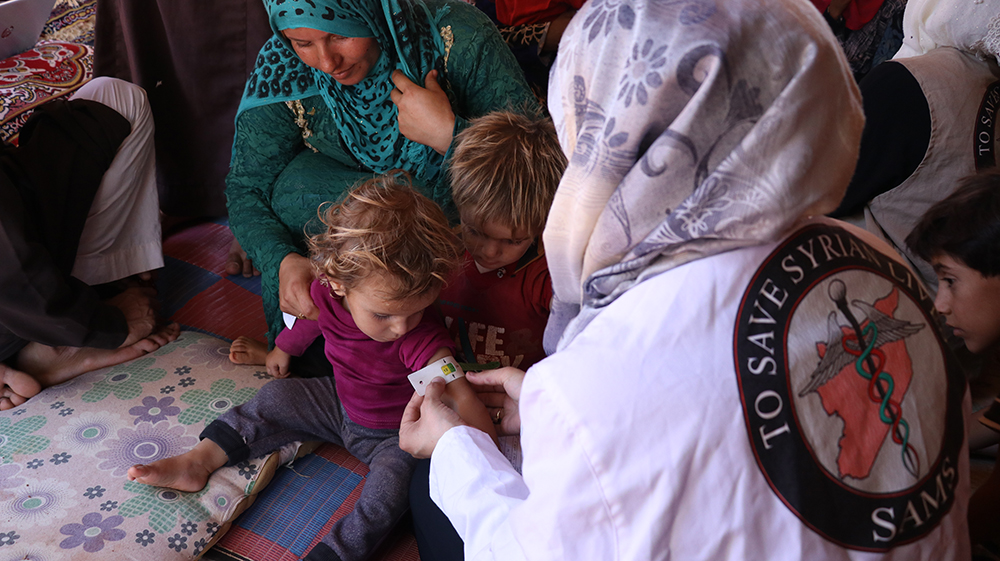- Background
Syrian American Medical Society (SAMS) Foundation is a nonprofit, non-partisan, non-religious medical relief organization, with a mission to provide lifesaving healthcare services and to revitalize health systems for underprivileged Syrian refugees, internally displaced persons, and vulnerable host community members in zones of conflict and displacement. This is done by implementing an integrated model of essential services that emphasizes priority needs, including the delivery of medical education, training, and financial support to physicians and other healthcare workers in Syria, Jordan, Lebanon, Turkey, Greece, and Iraq. Along with the provision of healthcare services and medical training, SAMS Foundation also implements mental health and psychosocial support (MHPSS) programs, as well as protection against gender-based violence (GBV).
SAMS is exploring opportunities to provide advanced quality learning initiatives for a range of mental health cadres in northern Syria. To do this SAMS will partner with universities in the region to provide accredited master’s degrees and professional diplomas in Clinical Psychology, Psychiatric Nursing, and Psychosocial Support to eligible candidates. The goal of this initiative is to provide local, long-term solutions for reducing barriers to MHPSS services while also providing individuals with improved access to professional education, employment and career advancement in a context where these opportunities have been disrupted.
- Purpose and specifications:
SAMS will conduct a scoping study in order to gauge the feasibility of implementing the proposed academic programs in northern Syria, and to determine the attributes that will contribute to their relevance, efficacy, impact, and sustainability. This study should (a) map the existing MHPSS workforce, education programs (both in-person and online), and training standards; (b) provide relevant information about prospective students, barriers to program completion, attitudes toward online programs, and factors that might lead to drop-outs; and (c) evaluate the capacity of prospective training sites as well as the market needs and locations of prospective employers. The contractor/firm will work together with SAMS MHPSS Specialist and relevant Programs and Operations staff to complete the tasks outlined below. The key study questions focus on assessments of the MHPSS workforce and education, as follows:
MHPSS Workforce Assessment:
This assessment should (a) inform staffing policies to rationalize decisions around workforce development and management, (b) contribute to a forward-looking recruitment and retention strategy, and (c) assess the potential returns on investment (i.e., comparing the project’s long-term gains with the costs invested by the donor and implementation team). Focus should be placed on workforce imbalances, cost-effectiveness of the proposed project, existing standards and practices, career pathways, attrition phenomena and risks, performance, management, and retention. Where appropriate, a Discrete Choice Experiment (DCE) methodology can be used to measure the preferences of mental health workers toward different posts and the factors influencing retention and sustainability.
What is the composition and distribution of the existing MHPSS workforce in northern Syria (i.e., psychiatrists, psychiatric nurses, psychologists, psychosocial workers)?
- What is the supply and demand for human resources related to service provision?
- What are the distribution imbalances?
- Which of the technical and geographical areas have the highest need?
- What is the educational background, credentials, experience, and workload of those who are currently practicing in public and private settings?
- What is the disaggregation by governorate, gender, and type of worker?
What are the existing standards, expectations, and practices for each MHPSS cadre?
Note: Technical specialists will support the lead consultant on this section
- What is the range of salaries offered through different types of employers?
- What are the job descriptions, roles, and responsibilities of each cadre?
- What knowledge, skills, and qualifications are required?
- What mentoring and supervision practices are currently in place?
- What is the availability of psychotropic medications, and who manages it?
- What are the career pathways for each cadre (if any)?
- How is practice regulated and by whom?
- Are there existing protocols for dealing with mental health patients?
- What is their workload? What task shifting practices are utilized?
- What legal, cultural, and social barriers to successful delivery currently exist?
Who are the main stakeholders related to MHPSS service provision in northern Syria?
- What are their roles and responsibilities with regard to supervision, licensing, workforce management, and deployment?
- What available options are there for hiring (private sector, NGOs, etc)?
- Which health facilities need graduates and are able to receive them? What is their level of commitment to hiring program graduates?
- What is the prevalence of use, satisfaction, and willingness to pay for MHPSS services?
- What incentives could help them improve deployment, retention, and service delivery?
- How are ‘public’ and ‘private’ sectors defined in each location, and what collaborations between private and public sectors could foster sustainability, scalability, and community acceptance?
- What associations and networks are currently in place for MHPSS professions, and what (if any) role do they play in standardization of the field(s)?
MHPSS Education Assessment
This assessment should (a) inform the upgrading of teaching and training in psychology and the behavioral sciences, (b) address equivalence of qualifications and portability of skills inside Syria, (c) contribute to a strategy for recruiting and training new specialists that minimizes attrition risks and ensures deployment of new graduates, and (d) identify points of complementarity with other programs and areas for partnership that will enhance sustainability and coverage of education programs.
How many eligible candidates are available to receive education in each cadre, and how can we support them in completing these programs?
- What is their formal education background and previous experience?
- What is the gender breakdown and any difficulties/needs related to gender?
- Where are they from, and where do they currently reside?
- Are they currently employed or have childcare responsibilities?
- What are their attitudes and expectations for these programs (e.g., prior experience with remote learning, extent to which they are willing and able to travel for education, language skills, career aspirations post-graduation)?
- What are the barriers to enrollment and continued enrollment?
- How can we mitigate this risk and increase their likelihood of graduation?
What are the current MHPSS programs across Syria?
Note: Technical specialists will lead this section with support from the consultant
- What degree or training programs already exist, and what is their quality (including undergraduate programs in nursing and psychology and postgraduate programs)?
- What contents, entry requirements, and training methods do they use?
- How much do these programs cost for the students/trainees?
- What are the training gaps?
- How well do the current offerings meet the needs of trainees and practitioners?
- What are the governance models, human resources, capacity gaps, and needed structural reforms at local higher-education institutes?
- How widely accepted are credentials/certificates/diplomas from training programs?
What are the needs of training sites and their attitudes toward the program?
- Which health facilities can support the practicums and internships?
- To what extent can they commit senior practitioners for field supervision?
- What is the expected workload and financial compensation for supervisors?
- Are there any licenses needed by the graduates before employment? If yes, who provides these licenses?
What are the associated costs for students in all phases of the proposed academic programs?
- What costs need to be included in the budget (e.g., internet, travel, tuition, etc.)?
- How could these costs be reduced?
- How could students be supported to meet costs?
- What is the availability and pattern of part-time work during the study period?
- Where post-graduate internships exist, what is a reasonable salary for interns?
- What costs do the participating facilities require (e.g., practicum/internship supervisors)?
What are the situational risks and constraints associated with delivering academic programs in Syria, to what extent can they impact project objectives, and what mitigation measures should be in place to safeguard project participants?
- Methods:
The consultant should select qualitative and quantitative methods to answer the key questions outlined above. The methods should engage local health facilities, health directorates and committees, coordination platforms, universities and education centers, NGOs, and potential program candidates within the proposed locations. The suggested design and tools should be clearly defined in the technical proposal submitted by the evaluator.
- Suggested Timeframe and Deliverables
| Tasks | Deliverable | Estimated # of days |
| Desk review of current MHPSS service provision, education/training programs, and any standards and regulations guiding the sector | Situation report summarizing existing service provision and programs | 15 |
| Develop a detailed design for the needs assessment based on the situation report and SAMS feedback from the original submission | Revised technical proposal with elaboration on work plan, proposed methods, and budget | 5 |
| Prepare assessment tools (e.g., questionnaires, interview procedures) and send to SAMS for review | Finalized assessment tools that will be used to collect data, reflecting feedback from the project team | 5 |
| Collect primary data from existing MHPSS workforce and prospective students, employers, and training sites | Raw datasets, including Excel files with questionnaire responses, interview transcripts | 20 |
| Analyze primary data and organize a workshop to debrief Programs team on initial findings | Presentation of summary of main results (bullet points) | 10 |
| Write draft of report, including any relevant figures and tables (in English) | Submission and presentation of needs assessment report | 15 |
| Revise final report with feedback from project team | Submission of final needs assessment report reflecting feedback | 5 |
Assessment start-date: January 2022
Final report specifications: The final needs assessment report should include: (a) Assessment design, data collection methods, and results; (b) Conclusions drawn from analyses of workforce gaps, attrition prevention, market demand, and absorption; (c) Summary of existing curricula, capacities, and needed structural reforms at higher-education institutions; (d) Selection criteria and processes for candidate trainees; (e) Needs/value added/opportunity costs/sustainability of trainee stipends; (d) Analysis of gender, socioeconomic status, and other inclusion indicators; (e) Associated costs including accommodation for trainees from hard to reach areas and supervisor compensation; (f) Licensure standards and delivery protocols; (g) Number of trainees per cadre and per geography, and target entities for building training capacity; (h) Mapping of relevant MHPSS stakeholders (associations, training centres, health directorates, universities, etc); (i) expected outcomes from the action; and (j) Recommendations for changes in project design.
Deadlines:
Preliminary Findings by April 2022
Draft by May 2022
Final report by June 2022
- Supervision
The evaluator is expected to work closely with SAMS MHPSS Specialist and relevant Programs and Operations staff, who will oversee implementation of the evaluation from the beginning through to completion. All deliverables will be submitted to the MHPSS Specialist.
- Payment Policy
The payment will be delivered in three phases:
- First payment after submission of the situation report and revised technical design (25%)
- Second payment after submission of raw datasets and summary of results (25%)
- Third payment after submission of the final needs assessment report (50%)
- Required Qualifications
Knowledge, skills, and experience:
- Advanced background in an MHPSS field (e.g. psychology, psychiatry, counseling)
- Previous experience designing and implementing mixed method research and needs assessments
- Extensive knowledge of the MHPSS sector, including practice and education
- Fluent in English and Arabic
Competencies:
- Highly organized; able to plan, implement and monitor work with attention to detail
- Ability to train and manage a team of enumerators to collect data
- Tolerance for operating in an environment characterized by uncertainty and ambiguity
- Ability to take initiative within clearly defined parameters
- Excellent written and verbal communication skills
- Adherence to agreed-upon deadlines and SAMS protection policies
- Application Materials
Interested applicants should submit the following in PDF format:
- CV/Resume
- 2-3 samples of previous needs assessment reports
- Technical proposal (2 pages maximum), including the overall procedure, qualitative and quantitative methods, proposed assessment tools, timeline, and analyses
- Budget, including the applicant’s daily rate (in USD), travel, accommodations, etc.
Please send the requested application materials to: careers@sams-usa.net

